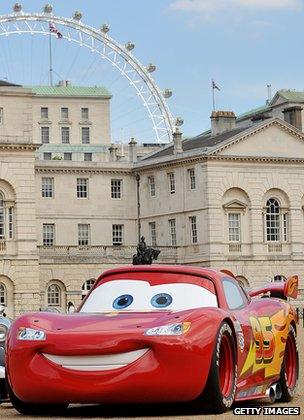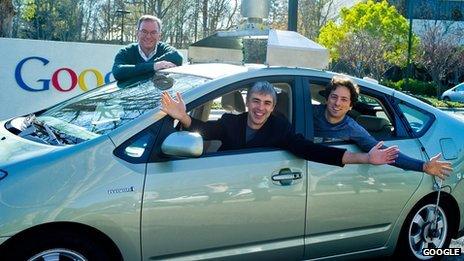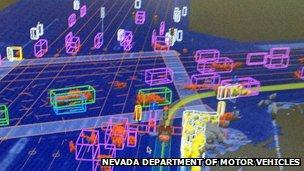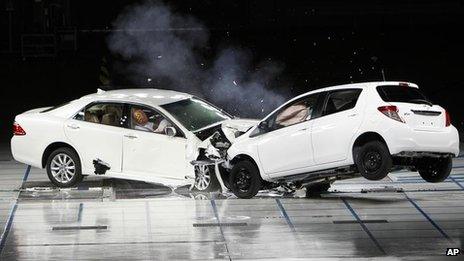Will chatting smart cars become a reality soon?
- Published

One day, there may be real-life versions of Lightning McQueen on our busy roads
"Yes, I'm a real race car, what do you think? Look at me."
Granted, there is not much chance that Lightning McQueen, a talking, grinning red hybrid between a Mazda Miata and a Dodge Viper from Pixar's animated film "Cars" will wink at you on the street.
But children watching such movies - many of whom will play on iPads before they play with a ball - will naturally expect their vehicle to be as smart as any other gadget they use by the time they reach the driving age.
Already, 46% of people between 18 to 24 would prefer internet connectivity to owning an automobile, if forced to pick between the two, according to Gartner.
Firms realise this - and are grappling to turn the concept of a "smart car" into an everyday reality.
Smart and connected
In the past few years, companies have been pouring huge amounts of money into research and development in the area of telematics - telecommunications and informatics - and the "internet of things", connecting physical objects to the web.
The world's biggest chipmaker Intel, for instance, has established a $100m (£62.9m) fund, dedicated to investing in firms developing connectivity for cars.
The company says that by 2014, automobiles will be among the top three fastest-growing areas for connected devices.

Connected cars could help drivers avoid traffic jams and collisions
One example of "car intelligence" is a US carmaker Ford's <link> <caption>voice-activated technology called Sync</caption> <url href="http://www.ford.com/technology/sync/" platform="highweb"/> </link> .
With Bluetooth, a wi-fi channel and a cloud service, it turns your automobile into a giant smartphone on wheels.
"Things like traffic directions and information are all in the cloud - if you don't have a navigation system in your car, or you don't want to use your phone while driving, you can just connect to the cloud using voice control to get directions," says Venkatesh Prasad of Ford's new division in Silicon Valley.
"Also, your kid may want to download a Mickey Mouse [cartoon] when you're going through a queue in McDonalds, and you want to do it as quickly as you can.
"That kind of download capability wirelessly by the car connecting to a secure VPN [virtual private network] environment and downloading media is not inconceivable."
Other companies are also aiming to make cars smarter by supplying automobiles with driving preferences of a particular driver via radio frequency identification (RFID) tags - non-powered smart labels that can be read by a nearby radio receiver.

Google has been testing its driverless Toyota Prius cars in the US
As the driver approaches the car, it would connect to, for example, car keys with such a tag in the driver's pocket, start the ignition, tune in to the preferred radio station, and adjust the seat and the temperature.
Avoiding collisions
But it is not only about digital comfort on the move - smarter vehicles can also improve safety.
Since 2010 Volvo has offered a feature on some of its models called <link> <caption>Pedestrian Detection</caption> <url href="https://www.media.volvocars.com/global/enhanced/en-gb/media/preview.aspx?mediaid=42212" platform="highweb"/> </link> which automatically triggers the brakes if a radar embedded in the car's grille detects an object in front of the vehicle and a camera confirms it is human-shaped.
Freescale Semiconductors is also working in a similar concept and says this is just the start.
"If you had vehicles communicating with each other, you could 'see around' corners and understand when there are problems on the road ahead," says the firm's marketing manager Steve Wainwright.
This could be much more effective than having a sat-nav device suggesting a new route because of a possible congestion ahead, he adds.
"Your car would simply send a signal out about traffic conditions to the car ahead, which would in turn 'communicate' with the one in front of it, and so on - and you would be getting traffic updates in real time," says Mr Wainwright.
No traffic lights
One way to do it could be by using a so-called operating system for cities, which manages smart objects, among them cars, equipped with embedded sensors.
A company called Living PlanIT, together with McLaren Electronic Systems, has developed such a platform, <link> <caption>called Urban OS</caption> <url href="http://www.bbc.co.uk/news/technology-15109403" platform="highweb"/> </link> .

Researchers say that a driverless car is able to process information much faster than humans
It is designed to run cities just like a computer operating system runs your PC.
It could facilitate communications of cars between one another as well as with the surrounding infrastructure - parking spaces and traffic lights - says Steve Lewis, head of Living PlanIT.
In an on-going trial in Porto, Portugal, several taxis have been equipped with special sensors that gather data about traffic conditions.
Urban OS then treats the data and communicates the information to the drivers, helping them to avoid collisions and traffic jams.
"We believe this can lead to the elimination of traffic lights, with driver instructions being provided inside individual vehicles, signage becoming internal instead of external," explains Mr Lewis.
"Already people are used to receiving navigational instructions from a sat-nav inside the vehicle, and as we get to scale when all vehicles are so equipped and are responding to real-time traffic information, sending everyone down the same alternate route - which today's sat-navs do - just isn't going to work."
"We need to load balance traffic across the road network depending on destination and maybe even priority - and that will require certain directional instructions to be mandatory, not just advisory."
Self-driving cars
With intelligence comes autonomy - and cars are no exception.
A number of carmakers and technology firms have been experimenting with driverless cars in recent years.
One of the best-known test runs is probably the VisLab Intercontinental Autonomous Challenge, a 13,000 km drive of four autonomous electric vans from Italy to China in 2010.
Among other companies, search giant Google <link> <caption>has tested driverless cars</caption> <url href="http://www.bbc.co.uk/news/technology-17989553" platform="highweb"/> </link> in the US.
The state of Nevada in May this year issued America's first self-driven vehicle licence to a Toyota Prius, modified with Google's driverless technology.
The automobile used video cameras mounted on the roof, radar sensors and a laser range finder to "see" other traffic.
In the UK, a group of Oxford scientists also made a driverless car attempt, testing a self-driven modified BAE Wildcat military jeep.

Smarter in-car computer systems could help improve safety
And although a self-driving car does not need to be connected, adding connectivity could help improve safety and efficiency, says Tim Edwards, senior engineer at MIRA, an independent engineering consultancy.
"Cars could form close-knit platoons on the motorway to improve throughput and fuel use, and in urban areas traffic speeds and routes could be alternated dynamically to improve everyone's journey time," he says.
So who knows - maybe in a few years, we will be heading to work in a real-life version of Lightning McQueen.
- Published10 May 2012
- Published8 May 2012
- Published12 July 2011
- Published17 September 2010